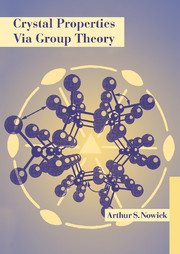Book contents
- Frontmatter
- Contents
- Preface
- 1 Tensor properties of crystals: equilibrium properties
- 2 Tensor properties of crystals: transport properties
- 3 Review of group theory
- 4 Linear relations treated group theoretically
- 5 The magnetic point groups and time reversal
- 6 Matter tensors of rank 0, 1 and 2
- 7 Matter tensors of rank 3
- 8 Special magnetic properties
- 9 Matter tensors of ranks 4 and 5
- 10 Matter tensors of rank 6
- Appendices
- A Review of tensors
- B Stress, strain and elasticity
- C Finite deformation
- D The great orthogonality theorem
- E The Symmetry-Coordinate Transformation tables for the 32 point groups and two infinite groups
- F Proof of the Fundamental Theorem
- G Theorems concerning magnetic groups
- References
- Index
1 - Tensor properties of crystals: equilibrium properties
Published online by Cambridge University Press: 18 December 2009
- Frontmatter
- Contents
- Preface
- 1 Tensor properties of crystals: equilibrium properties
- 2 Tensor properties of crystals: transport properties
- 3 Review of group theory
- 4 Linear relations treated group theoretically
- 5 The magnetic point groups and time reversal
- 6 Matter tensors of rank 0, 1 and 2
- 7 Matter tensors of rank 3
- 8 Special magnetic properties
- 9 Matter tensors of ranks 4 and 5
- 10 Matter tensors of rank 6
- Appendices
- A Review of tensors
- B Stress, strain and elasticity
- C Finite deformation
- D The great orthogonality theorem
- E The Symmetry-Coordinate Transformation tables for the 32 point groups and two infinite groups
- F Proof of the Fundamental Theorem
- G Theorems concerning magnetic groups
- References
- Index
Summary
A crystal is made up of a regular arrangement of atoms in a pattern that repeats itself in all three spatial dimensions. This structural feature has the practical result that most properties of crystals are anisotropic, that is, different values are obtained for the property when measured along the different directions of a crystal. This anisotropy distinguishes crystals from non-crystalline materials (glasses) or from random polycrystalline aggregates, both of which show isotropic properties.
The purpose of this book is to show how to analyze the anisotropic properties of crystals in terms of the (tensor) nature of the properties and of the symmetry of the crystals. In the first two chapters, we focus on the nature of the various properties with which we will be dealing. We will see how the tensor character of a property helps to define its variation with orientation. Questions of crystal symmetry will then be dealt with, starting from Chapter 3.
Definition of crystal properties
For a crystal, regarded as a thermodynamic system (i.e. in equilibrium with its surroundings), any physical property can be defined by a relation between two measurable quantities. For example, the property of crystal density is simply the ratio of mass to volume, both measurable quantities; similarly, elastic compliance is the ratio of mechanical strain to stress. Often, one of the measurable quantities can be regarded as a generalized ‘forces’ and the other as a response to that force.
- Type
- Chapter
- Information
- Crystal Properties via Group Theory , pp. 1 - 19Publisher: Cambridge University PressPrint publication year: 1995

